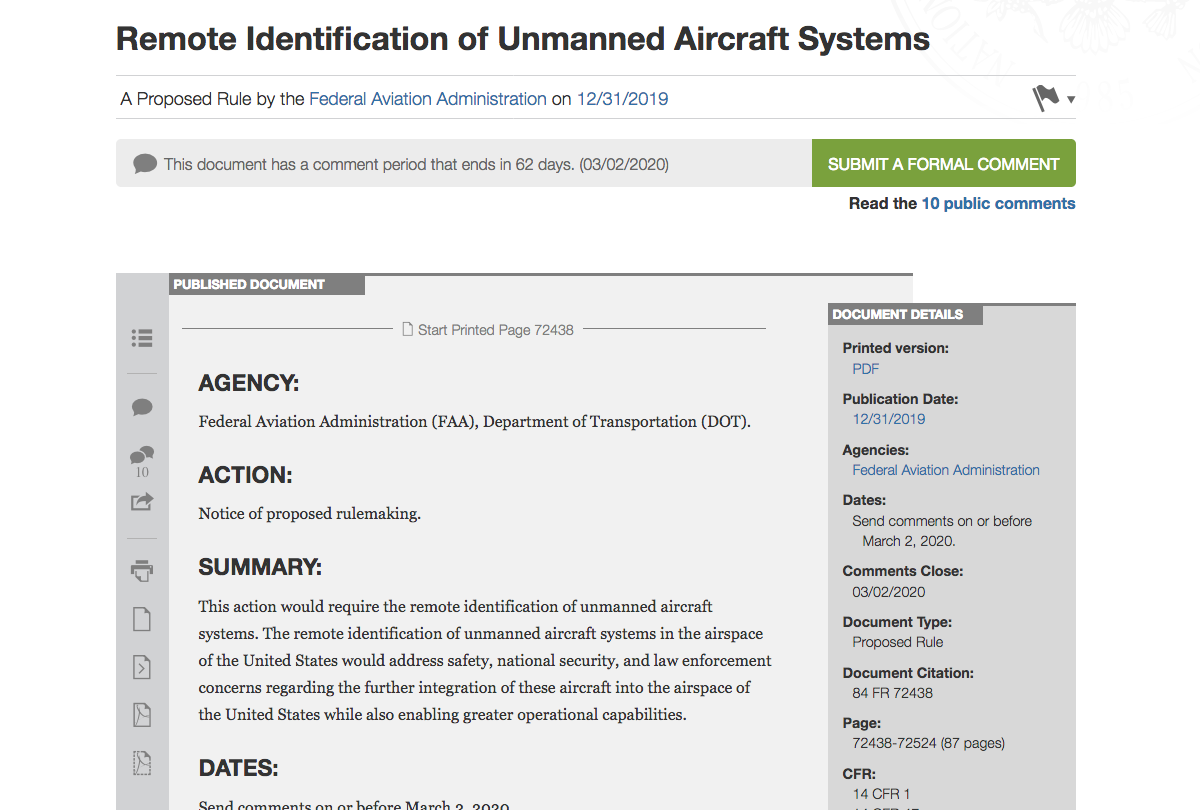Updated on 12/31/19 with the official opening of the RID NPRM on the Federal Register.
After numerous delays throughout the year, the FAA has finally delivered the long promised Notice of Proposed rulemaking (NPRM) on remote identification (Remote ID) for drones. The 319-page proposal is not an easy read, but given the impact this document will have on the present and future of the space, it’s essential to understand it.
Thankfully, experts from around the space have used what is normally the slowest time of the year to get to work and provide that understanding. Avionics International explores this development from multiple perspectives, while Miriam McNabb from Dronelife laid out some key details and context. Both CNET and Nextgov provide a baseline around this news, while Chris Korody has put together what is undoubtedly the most in-depth analysis of the proposed rule.
Generally speaking, the response from the wider drone community has been mixed. While the Small UAV Coalition welcomed the NPRM as a critical step in continuing to develop a risk-based regulatory framework and the Commercial Drone Alliance was thrilled to see the FAA’s proposed remote ID rule, responses from organizations like the Academy of Model Aeronautics (AMA) were a bit more muted. Vendors like AirMap and PrecisionHawk applauded the release of the rule, while DJI put out a statement that said the company was carefully reviewing the details. Based on some social posts from Brendan Schulman, DJI Vice President of Policy & Legal Affairs, you can guess where their more official position might end up.
This infographic distributed by FAA yesterday is wrong. It fails to show that broadcast solutions transmit ID data directly to law enforcement and to the public, as the FAA-influenced ASTM standard is designed to do. pic.twitter.com/cKY07isWzK
— Brendan Schulman (@dronelaws) December 27, 2019
These and other concerns have been echoed in numerous channels, but they’re most succinctly laid out in a piece by Vic Moss that focuses on how issues related to compliance are not addressed at all in the NPRM. More analysis that explores all of these concerns (as well as the timetable that might not see full compliance until 2026) will undoubtedly be coming out over the next few weeks as we approach March 2nd, which is when the FAA is looking to finalize this proposed rule.
That timetable is what drone operators should be focused on as it gives the drone industry as a whole the opportunity to help define the future of the space. Whether you’re thrilled, discouraged or uncertain about what the FAA has laid out in the NPRM, providing comments and feedback to the FAA can help shape final regulation. Now that the 319-page NPRM has been published, the general public has 60 days to post comments for the FAA's consideration. These 60 days are a critical time for the industry and stakeholders across the space need to take action.
Part 107 has allowed drones to make a difference in industries that range from construction to energy to public safety, but many of those differences can only scale or be taken to the next level with an identification system that ensures public safety and the interests of compliant, law-abiding drone pilots are prioritized. Few can imagine how BVLOS operations, much less UTM and UAM ecosystems, will be enabled without Remote ID. Is what the FAA has proposed the best way to get there? That’s something drone operators can define and determine, and the FAA needs to hear from the community around numerous issues that are and are not in the NPRM. Thankfully, they’re actively soliciting comments from the public to better inform this rulemaking process.
This 60-day public comment period for the NPRM on Remote ID for drones has already begun. The FAA will post the comments it receives as part of this process, without any editing, to https://www.regulations.gov. The docket number is FAA-2019-1100.
The NPRM for Remote ID should mean that the drone industry recognizes what's at stake when it comes to the future of the airspace. It should mean that operators of all types commit to helping define what drone regulation should look like and conveying that to the FAA. This opportunity isn't going to last forever, which is why it's essential that everyone read the NPRM and take an active part in the rulemaking process.
















Comments